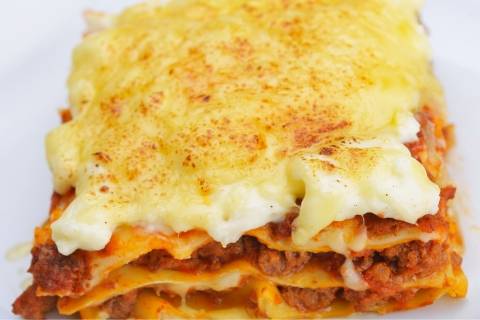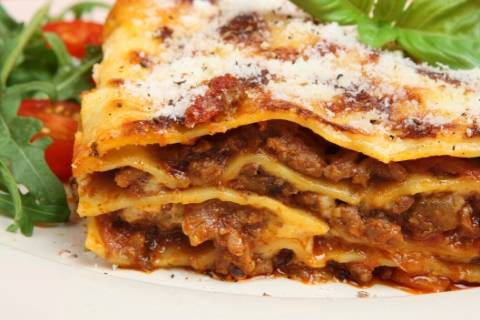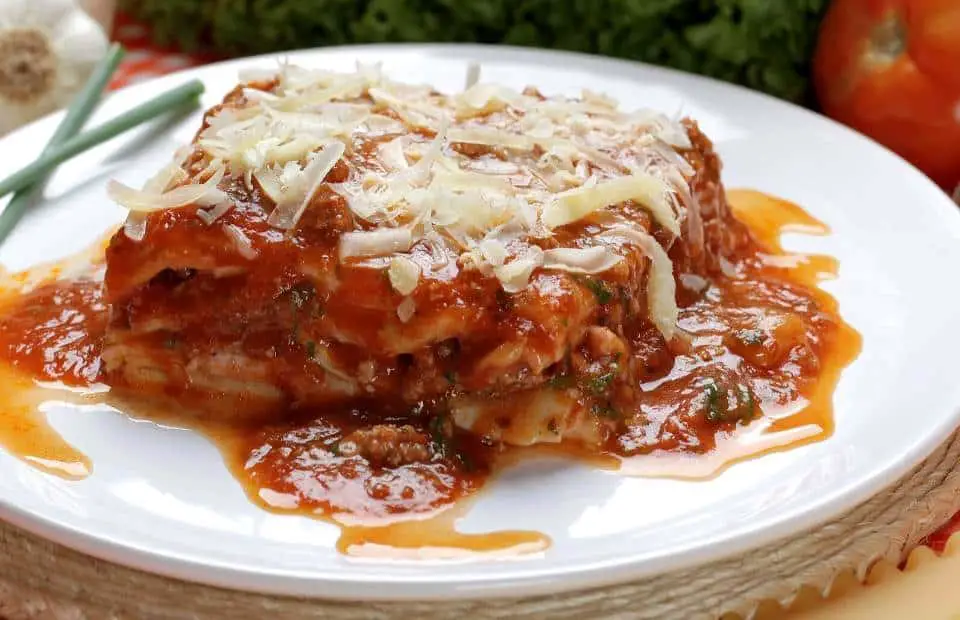In order to avoid runny or watery lasagna you should know what commonly causes this cooking blunder. Then you can isolate the problem and start perfecting your next lasagna.
Once you know the possible culprits, its easy to identify where in the cooking process your lasagna is becoming watery.
Typical Causes of Watery Lasagna
- Overfilling
- Over layering
- Excessive sauce
- Excess fat in meat sauce
- Inaccurate ingredient measurement
- Wet noodles
- Slicing/eating your lasagna fresh-out-of-oven (aka “not letting it rest”)
- Trapping Steam Within The Pan
Examine the sauce
If you ended up with overly wet lasagna, your sauce is a prime suspect. Some can be watery than others. Even a well-made marinara recipe doesn’t cut it for lasagna.
With your cooking spoon, scoop about 4 ounces of sauce into a bowl. Observe it, if it forms a flat pool too quickly, or you notice tine liquid ‘weeping’ out around the tomatoes, that’s a red flag. Unlike for noodles like spaghetti, you need a thicker sauce for your lasagna. There are a couple of ways to achieve that level of thickness.
Add tomato paste – about a few tablespoons – and stir. Simmer until the paste disperses.
Cheat mindlessly and add some cornstarch to thicken the sauce.
You may also thicken your sauce with ‘gravy’ flour mixed with tomato juice or cold water.
Simmer your sauce. As the moisture evaporates, your sauce gets thickened naturally. Even more, this, in some way, makes a more robust flavor. So, if time is on your side, this may be your best option.
Pro tip
It’s most likely you’ve been adding excess sauce. We’d recommend only a few tablespoons for each layer. The general rule says: just enough to prevent your noodles from drying out.
Should Lasagna Sauce Be Thick or Runny?
The sauce your using should be thick enough to help keep the noodles sticking together. You can either thicken up your sauce by heating it up or using corn starch or flour.
You want to get rid of any pure liquid that separates from the best parts of the sauce.
Watch the cheese
Too much moisture in the cheese layer can also ruin your recipe. The whey in your cottage cheese with low fat or ricotta reduces as a result of your oven’s heat. So, here’s a thoughtful starting point.
As much as possible, prefer full-fat cheese. Squeeze out excess moisture from the cheese, as much as possible, before you add to the lasagna. Being an indulgent dish, it’s okay to reduce the portion size.

You may sprinkle a handful of finely shredded parmesan or any preferred dry cheese. This does not only absorb excess moisture; it adds more flavor.
Lastly, whip one or two eggs into your cheese layer. This helps prevent your whey from escaping. Even more, chipped eggs will help retain your cheese’s creaminess.
Screen out the add- ins
If you wish to add some nutritious ingredients to your lasagna, going overboard may cause a watery end product. Onions, zucchini, mushrooms, sweet peppers, and spinach are all water-rich. To prevent these add-ins from ruining your stuff, you may cook out the water before including it. Carefully, you can gently sauté spinach, onions, and mushroom in a skillet – individually, or together.
Normally, you may squeeze out excess moisture from the spinach after cooking. Based on your preference, your sweet peers and zucchini can be roasted or sautéed.
Too many layers may ruin it
Here’s a guide to layer your lasagna:
- Cover your baking dish with a thin layer of sauce
- Add a layer of prepared lasagna noodles
- Make another layer of your ricotta/cottage cheese mixture.
- Make a layer with your meat sauce
- Repeat the layers twice
- Conclude with a last layer of sauce, noodles, parmesan cheese, and mozzarella.
Avoid Overly Wet Noodles
In your fight against watery lasagna, noodles are your best weapons. However, the wrong usage may ruin your recipe even more.
For everyday dry noodles, simply cook until they become flexible instead of completely al dente. Remember, your noodles would spend so many minutes in hot sauce.
Just blot-dry the noodles and place them in your cooking pan, where they’d get more moisture and spend the entire cooking time. You do not need to boil no-cook noodles and fresh pasta beforehand. This makes your preparations simpler and faster.
Either way, you’d get to extract the needed moisture from your sauce.

Allow The Lasagna To Rest Before Slicing and Serving
Just when you think you’ve dotted all I’s and crossed all T’s, you may still discover watery lasagna. Don’t feel bad – at least, not yet. If you cut your lasagna fresh-out-of-oven, your lasagna may look watery.
Ideally, allow your lasagna to cool for about 20 to 30 minutes before you serve.
Your lasagna won’t get cold yet, and the sauce, cheese, and noodles would have had enough time to synergize.
Besides that the ingredient would have been more composed, you’d have also prevented some unexpected mouth burns from the super-hot cheese or sauce.
You may also consider baking your lasagna beforehand – perhaps, a day before. This causes a mature flavor. Also, this affords the noodles enough time to suck up the excess soup.
Be Careful With Foil Covering
Another possible culprit for watery lasagna is the moisture resulting from the trapped steam. When you cover lasagna with foil during the first half of baking. Steam that comes off the lasagna gets trapped inside.
This steam builds up underneath your foil layer and drips back down into the lasagna. Make sure to bake the lasagna for a set amount of time uncovered.
The reason a lot of recipes say to cover your lasagna is to avoid overcooking the top layer of noodle. Foil over the top does a good job of preventing this. Just make sure to allow it to bake uncovered for a good amount of time as well.
Some recipes use a rule for covered baking time and uncovered. Like 70% uncovered baking and 30% covered near the finish.
A lot of that moisture is going to prevent the top layer from overcooking anyway. So maybe you don’t need to bake the lasagna covered for as long as the recipe states. You can also poke a couple holes in the foil to allow some steam to escape.
How to Fix Watery Lasagna
Fixing a runny or watery lasagna is tricky but this can work.
Allow your hot lasagna to cool down by placing it in the fridge for at least an hour, but the longer the better.
Then simply reheat the lasagna low and slow. Just be cautious of overcooking the top layer of noodles, You can use foil with holes poked in the top to prevent this.
Refrigerating the lasagna actually helps it to dry and become more firm.
Additional tips
- Bake with a glass dish
Baking in a glass dish will help you monitor how much liquid the casserole has and it always presents well. See this perfect glass lasagna pan on Amazon.
- Prefer an oven thermometer
Before you begin, use an oven thermometer to check your oven’s temperature. Your dial may be inaccurate. If you notice an uneven baking, rotate your pasta accordingly.
- Accurate ingredient measurement will help
Typical of baking, eyeballing ingredients may ruin the entire process.
Also, before you substitute any item on the recipe, be sure it won’t cause excess moisture.
For instance:
- If the recipe says grate ingredients, chopping them might harm the result
- Downplaying instructions like ‘drain excess liquid’ might turn out a big regret.
- Stick to recommended baking dishes.
- Prefer lean ground beef
Although more-fatty beef may be cheaper than its lean counterpart, its excess fat may add more moisture. Do well to remove excess liquid from your meat before you add to the baking dish.
Pasta can be a delight – but definitely not a watery lasagna. If your previous attempts were a mess, sorry about your experience. But, hopefully, with this guide, never again.


